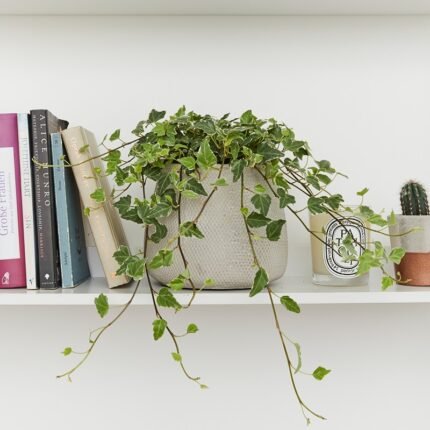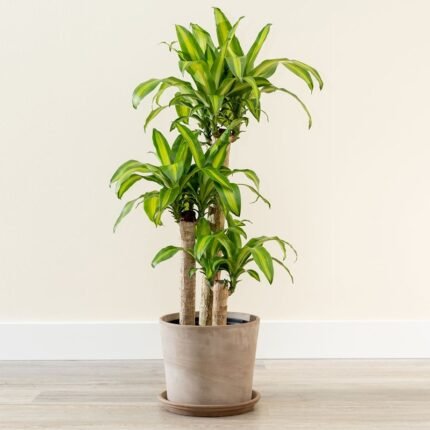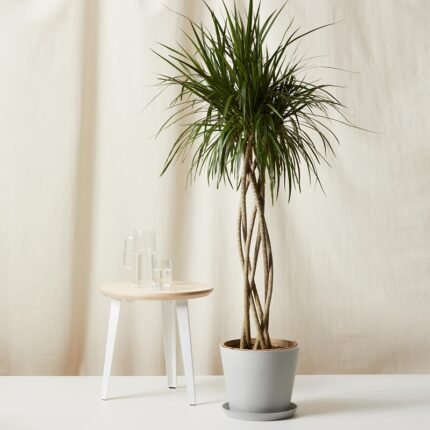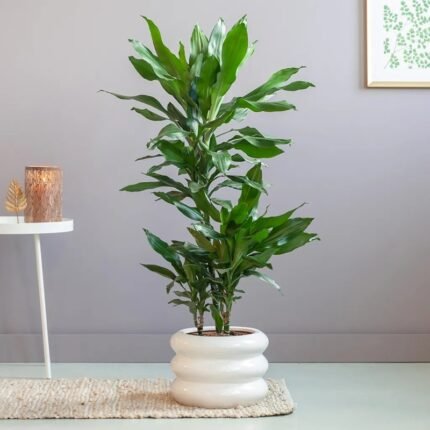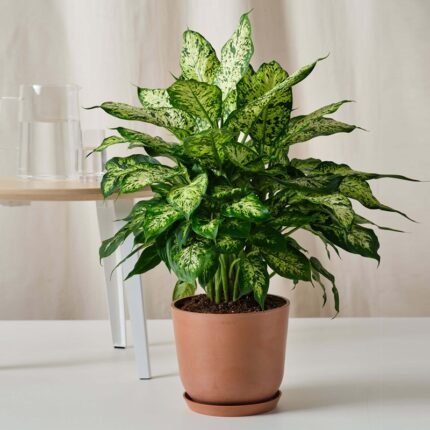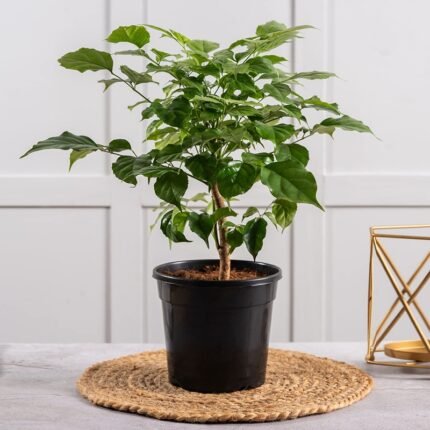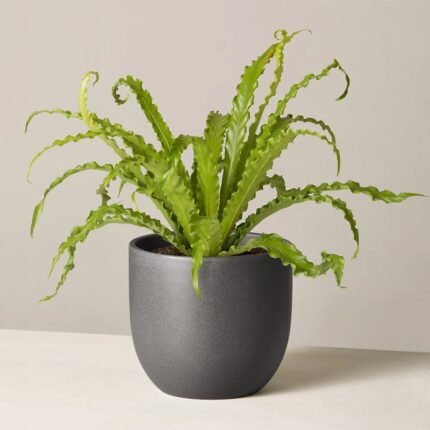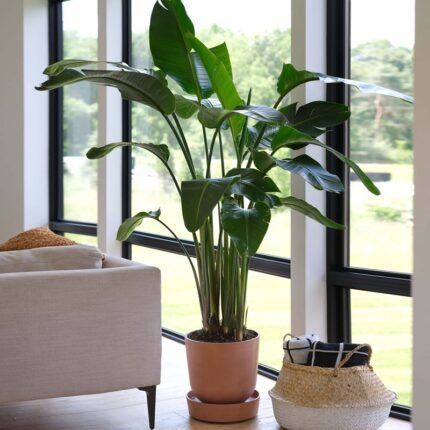ENGLISH IVY
English ivy (Hedera helix) is an evergreen perennial. It is also classified as a woody vine. English ivy can act as a ground cover, spreading horizontally. But it is also a climber, due to its aerial rootlets, which allows it to climb to 80 feet high. The plant will eventually bear insignificant greenish flowers, but it is grown primarily for its evergreen leaves. In this regard, ivy can be classified as a foliage plant. The best time to plant English ivy is spring. It is a fast, aggressive grower that is considered invasive in many areas. Keep a watchful eye on children and pets because English ivy is toxic to humans and animals.
DRACAENA MASSANGEANA
Dracaena Massangeana is also called the Happy Plant because of the simple nature of this plant. It helps to filter out toxic air inside homes and offices. Dracaena Massangeana needs moderate to bright indirect light and is ideal for offices or fluorescent lighting. Avoid direct sunlight as this may burn or bleach the leaves. Water when the soil starts to dry-out at the top. Water well and allow to drain thoroughly. Relatively drought tolerant. Do not overwater as this will cause the leaf tips to blacken. Dracaena are hardy houseplants and will do well in normal room humidity, however they do prefer higher humidity and will benefit from occasional misting.
DRACAENA MARGINATA – DRAGON TREE
Dracaena marginata, more commonly known as a dragon tree, is an attractive plant with green sword-like, red-edged leaves. Native to Madagascar, the eye-catching spiky tree is known as a great entry plant for household gardeners—it’s easy to care for, drought-tolerant, and nearly indestructible. The slow-growing plant can be planted year-round and boasts tiny white flowers in the spring (though it rarely flowers indoors). This small tree will grow to about 20 feet in warm outdoor climates, but it is generally grown as a potted houseplant and kept pruned to 6 feet or less.
DRACAENA LEMON LIME
Dracaena Lemon lime are very widely grown as an ornamental houseplant, which is valued mostly for their evergreen dark-green leaves and neon yellow stripes on them. This Massangeana plant will get you a display of profuse attraction in your personal spaces. Unlike other Dracaena plants, Dracaena Lemon lime requires a bit more light to get to its mature state. And once they mature, they form into a beautiful bush. While in indoor conditions, Dracaena Lemon lime has a tendency to grow in a range of 1.5 – 2 m. It will be a great choice to select this plant for any of your inhouse space as it will brighten up any room. Usually kept to a tabletop size with regular pruning.
DRACAENA JANET CRAIG
Dracaena Janet Craig is an excellent low-light interior plant. Add her ability to handle low humidity, air conditioning, plus infrequent care – you have the making of a very durable indoor plant. It survives low light levels but grows best however in filtered indirect light, but no direct sunlight. Its evergreen, glossy leaves and tall growing habit combine to make the Janet Craig plant a perfect fix for an empty corner.
DIEFFENBACHIA – DUMB CANE
Dieffenbachia is a tropical perennials with several species that are commonly grown as houseplants. They feature pointed, ovate leaves in a variety of combinations of green, cream, and white colors. A large, well-grown dieffenbachia can reach 10 feet, with leaves 20 inches long. However, the plants will rarely reach this size in typical indoor conditions, where 3 to 5 feet is more common. Dieffenbachia is a fast-growing plant that can achieve 2 feet in height within a year of planting a rooted cutting, provided it gets enough light. Though the name “dumb cane” has fallen out of favor as a derogatory term, it got that name because the plant contains toxins in all of its parts (including its roots and sap) that, if it is in contact near the face or ingested, it can inhibit speech.
CHINA DOLL
China doll plants are broadleaf evergreens that have a moderately fast growth rate indoors. These plants have small, glossy green leaves and an upward growth habit that can reach 4 to 6 feet tall at maturity. China doll plants do best when grown in full sun or bright, indirect light along with moist, well-drained soil. Native to the subtropical mountainous regions of Asia, China doll plants have a feathery, eye-catching appearance that can bring a pop of greenery to any corner of the home when grown indoors.
CALATHEA ORBIFOLIA
It’s not hard to see why so many houseplant enthusiasts covet calathea species. These striking tropical beauties have distinct stripes and veining on their oblong foliage. However, they’re not always the best choice for plant lovers as they’re particular when it comes to the care and conditions they require (frequent watering and high humidity). The round-leaved calathea (Calathea orbifolia ) is no exception. The silver-green stripes on its luxuriant, large leaves make it a bold statement plant, but it’s somewhat fussy and definitely doesn’t fall into the low-maintenance category.
CACTUS CLUSTER
Cacti are succulent perennial plants. Cacti generally have thick herbaceous or woody chlorophyll-containing stems. Cacti can be distinguished from other succulent plants by the presence of areoles, small cushion like structures with trichomes (plant hairs) and, in almost all species, spines or barbed bristles (glochids). Areoles are modified branches, from which flowers, more branches, and leaves (when present) may grow. Varieties of Cactus plants look amazing when lined up beside bright window sills or when kept together potted on a large bowl-shaped planter. And they are easy to look after too.
BIRD’S NEST FERN
Bird’s nest ferns (Asplenium nidus) are epiphytic ferns, meaning they grow on the surface of other plants in their rainforest habitat. These ferns have long, erect bright green fronds that grow from a central rosette. Unlike some other ferns, which grow feathery leaflets, bird’s nest ferns have smooth, lance-shaped fronds that sometimes develop gentle ripples when grown with sufficient light. Bird’s nest ferns prefer medium to bright indirect light, high humidity, and moist, well-drained soil. Because they thrive in warm, humid environments, these ferns make an excellent choice for a bathroom.
BIRD’S NEST FERN
Bird’s nest ferns (Asplenium nidus) are epiphytic ferns, meaning they grow on the surface of other plants in their rainforest habitat. These ferns have long, erect bright green fronds that grow from a central rosette. Unlike some other ferns, which grow feathery leaflets, bird’s nest ferns have smooth, lance-shaped fronds that sometimes develop gentle ripples when grown with sufficient light. Bird’s nest ferns prefer medium to bright indirect light, high humidity, and moist, well-drained soil. Because they thrive in warm, humid environments, these ferns make an excellent choice for a bathroom.
BARKIN
Philodendrons are one of the most loved and widely grown indoor plant species in the world, but what is better than a regular philodendron is a variegated one. The Philodendron Birkin has a stunning dark green color with elegant white variegations resembling fish bone. Birkin plant’s leaves are glossy, heart shaped, ovate and bring an interesting charm to any space. These patterns might make you think that the Philodendron Birkin is a difficult plant to take care of, but luckily that’s not true. The Philodendron Birkin shows you when it’s not happy, which makes it the perfect plant for beginners. Tropical Philodendron birkins come from the Araceae family. Philodendron is a subcategory of this family






